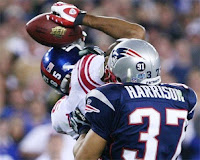A successful innovation cycle goes like this:
Innovate à Reap rewards à Be Copied à Innovate
The pattern is the same in business, sports and most disciplines I can think of. The vast majority of innovations are incremental and provide an advantage for a short period of time. Then, once in a great while, a disruptive change comes along that upsets an entire industry.

In 1985, William “The Fridge” Perry was drafted by the Chicago Bears and joined a handful of super-sized players who weighed over 300 pounds.
The Fridge weighed closer to 380.
He was a huge fixture (appliance?) on the defensive line for the Bears but opposing teams considered him too slow to be much of a factor and they simply ran around him.
You can run or work around one big obstacle.
On the other hand, if you put 4 or 5 of them side by side, the game changes and this is what has happened in professional football over the past three decades. In 1980, just prior to The Fridge joining the league, there were only 3 300-pounders in the NFL. Then Perry and others ate their way into this club and by 1990, 94 players tipped the Toledo over 300. By 2000, it had become the norm with more than 300 300-hundred pounders in the league, an average of 10 per team. Now, there are over 400.
The college game has followed suit. For example, the starting offense lines in the upcoming national championship game between Oregon and Auburn average 296 and 307 pounds, respectively.
The impact to the game has been dramatic and it is fair to characterize the 300-pound phenomenon as a disruptive change. Combined with the increasing specialization of players and sophistication of offensive and defensive schemes, every play has become its own major production. This takes time and, if you watch, you’ll notice that most teams take the full 30 seconds allowed between plays. Personnel frequently swap in and out, often carrying instructions for the next complicated play from the sideline to the team on the field. The other benefit of using the full 30 seconds between plays is that it allows the players, particularly the big men, to catch their breath.
Now comes a disruptive change by the University of Oregon and its coach, Chip Kelly. Yes, the University of Oregon! Surprised it’s not one of the perennial powerhouse teams like USC, Texas or Alabama?
Oregon runs its plays twice as fast as most teams with an average of only 17 seconds between plays and sometimes as little as 5 seconds. The essence of this strategy is simple – to exhaust the opposing defense – but the implementation involves a number of additional innovations. Kelly calls plays in sets rather than one at a time. As a result, Oregon’s offense seldom requires a huddle to call the next play. When they do need to communicate with the sidelines and each other, the coaches use big flash cards with a symbol-based language. The sequence of plays take into account the intended location of each player at the end of the play and minimizes re-alignment for the next play. Player substitutions are pre-planned and made the instant the previous play has been completed. All of these innovations are designed to shorten the time between plays.
The pace of Oregon’s offense is unique and it is completely counter-cultural to today’s highly-specialized play-by-play game. Everything teams have done in recent decades to compete more effectively works against them. They don’t have time to reset their defenses, to substitute specialized players for certain game situations or even to give their players a moment of rest. Imagine the frustration! Several times this season, opponents have even faked injuries to try to slow the game but exhaustion is inevitable. Oregon has scored an average of nearly 50 points per game, is undefeated and playing for the National Championship game on January 10th. The strategy is working.
I am particularly intrigued with designing successful strategies and balancing conformance and differentiation. What I mean is that you have to conform to the game as it is played before you can do something different. For example, Oregon’s strategy has to conform to the rules of football and compete with strength, size and specialization of the opposing teams.
In my world whether pitching a new project or finding the win-win between deal partners, there are always requirements that must be met as the first order of business. The client or deal partners need to know that you can meet their expectations, work within the law and meet the needs of the market.
However, you seldom win by just meeting the specs. Winning requires something extraordinary, unexpected, insightful or delightful to differentiate from the competition. For example, in previous years with a more conventional offense, Oregon was just another good team but not a champion. Seth Godin wrote in a recent blog, “the act of deciding [where to stand out] is the important innovation. Some of the elements you use should be perfectly aligned with what we're used to. The others... Not a little off. A lot off."
The less you are known, the more this is true. This prompts unknown upstarts to take great risks and is why most great innovations and disruptive changes come from unexpected sources, like the University of Oregon.
*********************
Merry Christmas and Happy Holidays to you, my friends.
David



